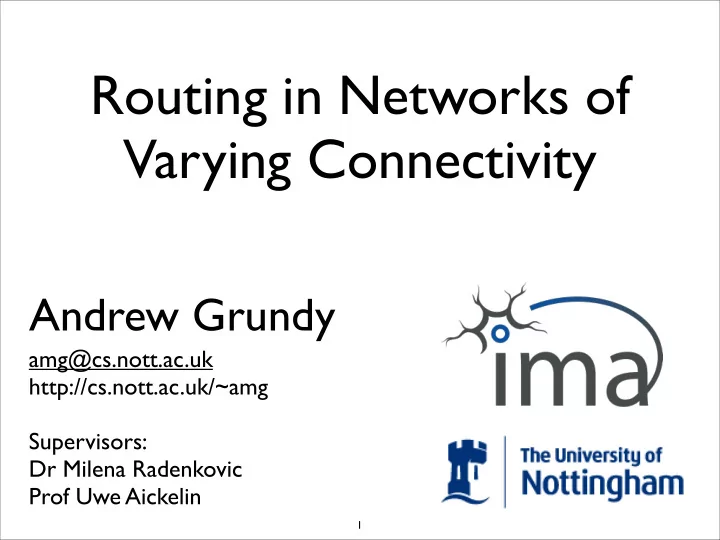

Routing in Networks of Varying Connectivity Andrew Grundy amg@cs.nott.ac.uk http://cs.nott.ac.uk/~amg Supervisors: Dr Milena Radenkovic Prof Uwe Aickelin 1
Overview • The Problem Domain • Existing Solutions • My Work • The Evaluation • Questions 2
The Problem Domain Wired Networks Node AP Wireless Networks Node Node Wireless Ad-Hoc Networks Node Node 3
The Problem Domain Mobile Wireless Ad-Hoc Networks Mobile Ad-hoc NETwork (MANET) Node Node Node Disconnected Mobile Wireless Ad-Hoc Networks Disconnection Tolerant Network (DTN) 4
The Problem Domain Mobile Ad-hoc NETwork (MANET) • End-to-end connectivity is assumed • Topology is not Fixed • One-hop set (neighboring nodes) may change Disconnection Tolerant Network (DTN) • End-to-end connectivity is not assumed • Topology is not Fixed • One-hop set is likely to vary considerably 5
Existing Solutions MANET Routing Pro-active Dynamic Source Routing [2] Constantly maintain a view of the entire network. Re-active Acquire a route when you need it . 6
Existing Solutions DTN Forwarding [5] Wait Hold onto a packet , until you connect to the destination. Restricted Flood Beacon the packet hop by hop decrementing the time to live . Controlled Flood Only forward to a subset of nodes , selected based on previous experiences forwarding packets to them. 7
Existing Solutions Reactive Routing and Forwarding Integrating DTN and MANET routing [3] Two Classifications of Node Gently [6] MANET Proactive Routing & Forwarding Node Bridge MANET DTN Node Node Node DTN Node
Dynamic Source Routing (DSR) Route Acquisition A C B Route Route Route RREQ ID: ID: 1 1 To B? To A? Request Route: Route: A A,C Route Request / Update Route ID: 1 RREQ / RREP Routing Table Reply ID: 1 To A? Route: B Route: B,C RREP: A,C RREP: A,C Piggyback Route Update Forward RREP ID: ID: 2 2 Routing Table Reply RREP: RREP: B, C B,C 9
Dynamic Source Routing (DSR) Route Failure A C B Send Data Data Forward Receive? Update Routing Route Fail RFAIL Table 10
My Work [1] Why Dynamic Source Routing? • Disconnection Tolerant Route Acquisition What are the assumptions? • Disconnection Tolerant Data Forwarding Why not TCP? • Packet Scheduling / Duty Cycling Why is this needed? 11
Route Acquisition Over Time A C C` C`` B A A,C,C`,C`` A,C,C` A,C id=2 id=2 id=2 id=2 D D` D ` ` D` ` ` B A A,D,D`,D``,D``` A,D A,D,D` A,D,D`,D`` id=2 id=2 id=2 id=2 id=2 History E E` B A A,E A,E,E’ id=2 id=2 id=2 12
Route Acquisition - Acknowledgement A C B Route Route RREQ ID: To B? ID: To A? 1 1 Route: Route: A A,C Update RQAK Knowledge ID: 1 Route Update 1 RREQ / RREP ID: To A? ID: 1 B Route: Routing Table Route: B,C A,C RREP: RREP: A,C Update RQAK ID: 2 Knowledge Update Forward RREP ID: ID: 2 2 RREP: RREP: Routing Table B, C B,C 13
Disconnection Tolerant Data Forwarding Pass Packet To We Are Destination Application Level Receive We Are Source Drop Packet Packet We Are On Route Forward Packet On Fail Send Route No TTL > 0 Failure Packet On Fail Yes Resend Packet 14
Packet Scheduling / Duty Cycling Day 1 On OFF C B D F E C B C B F G D E G Day 2 On OFF C B F D E C B C B F G G E D Day 3 On OFF Based on Efficient Node Discovery Algorithm [4] 15
The Evaluation 16
The Evaluation Average Delay (Seconds) Success Ratio (%) 1.0 DSR & Zigbee 5 � DSR & 802.11 DSRR & Zigbee DSRR & 802.11 � 0.8 4 � � 0.6 � Average Delay Success Ratio 3 � � � � 0.4 2 � � � � � � � � 0.2 � 1 � � � � DSR & Zigbee � � � � � � DSR & 802.11 � � � � � � DSRR & Zigbee � 0.0 � DSRR & 802.11 � � � � � � � � � � � � � 0 20 40 60 80 100 20 40 60 80 100 Number of Nodes Number of Nodes 17
The Evaluation 802.11 Routing Packet Count Data Packet Count 100 MDSR � MDSR � MDSRR MDSRR 30000 25000 80 RoutingPacketCount 20000 DataPacketCount 60 15000 40 10000 5000 20 0 MDSR.10 MDSR.25 MDSR.50 MDSR.75 MDSR.90 MDSRR.100 MDSR.10 MDSR.25 MDSR.50 MDSR.75 MDSR.90 MDSRR.100 Number of Nodes Number of Nodes 18
The Evaluation Zigbee Routing Packet Count Data Packet Count 100 1400000 MDSR MDSR � � MDSRR MDSRR 80 1000000 RoutingPacketCount DataPacketCount 60 600000 40 � 20 200000 � � � � 0 0 MDSR.10 MDSR.25 MDSR.50 MDSR.75 MDSR.90 MDSRR.100 MDSR.10 MDSR.25 MDSR.50 MDSR.75 MDSR.90 MDSRR.100 Number of Nodes Number of Nodes 19
References 1. Andrew Grundy and Milena Redankovic. Routing In Wireless Networks Of Varying Connectivity . In The Fifth International Conference on Wireless and Mobile Communications, 2009. 2. D. Johnson, D. Maltz, J. Broch et al., “ DSR: The dynamic source routing protocol for multi- hop wireless ad hoc networks ,” Ad hoc networking, vol. 5, pp. 139–172, 2001. 3. J. Ott, D. Kutscher, and C. Dwertmann, “ Integrating DTN and MANET routing ,” in Proceedings of the 2006 SIGCOMM workshop on Chal lenged networks. ACM New York, NY, USA, 2006, pp. 221– 228. V. Dyo and C. Mascolo, “ E ffj cient Node Discovery in Mobile Wireless Sensor Networks ,” 4. Lecture Notes in Computer Science, vol. 5067, pp. 478–485, 2008. 5. Z. Zhang, “ Routing in intermittently connected mobile ad hoc networks and delay tolerant networks: Overview and challenges ,” IEEE Communications Surveys & Tutorials, vol. 8, no. 1, pp. 24–37, 2006. 6. M. Musolesi, P. Hui, C. Mascolo, and J. Crowcroft. “ Writing on the clean slate: Implementing a socially-aware protocol in Haggle ”. In World of Wireless, Mobile and Multimedia Networks, 2008. WoWMoM 2008. 2008 International Symposium on a, pages 1–6, 2008.
Thank You! Any Questions? Andrew Grundy amg@cs.nott.ac.uk http://cs.nott.ac.uk/~amg 21
Recommend
More recommend